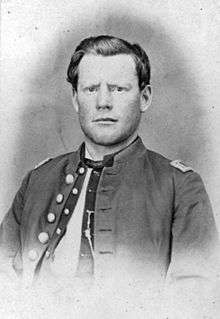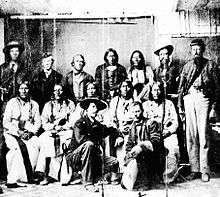Silas Soule
| Silas S. Soule | |
|---|---|
 Captain Soule, c. 1864/1865 | |
| Born |
July 26, 1838 Bath, Maine, United States |
| Died |
April 23, 1865 (aged 26) Denver, Colorado Territory, United States |
| Place of burial | Riverside Cemetery (Denver, Colorado) |
| Allegiance |
|
| Service/branch |
Abolitionist Militia Union Army |
| Years of service | 1861–1865 |
| Rank |
|
| Unit |
1st Colorado Infantry 1st Colorado Cavalry |
| Commands held | Company D, 1st Colorado Cavalry |
| Battles/wars | |
Silas Stillman Soule (July 26, 1838 – April 23, 1865) was an American abolitionist, Kansas Territory Jayhawker, anti-slavery militant, and a friend of John Brown and Walt Whitman. Later, during the American Civil War, he joined the Colorado volunteers, rising to the rank of Captain in the Union Army.
Silas Soule was in command of Company D, 1st Colorado Cavalry, which was present at Sand Creek on November 29, 1864, when he refused an order to join the Sand Creek massacre. During the subsequent inquiry, Soule testified against the massacre's notorious ringleader, John Chivington, and soon after, he was murdered in Denver, presumably in revenge for this act.
Biography
Early life and "Bleeding Kansas"

Silas Soule was born into a family of abolitionists in Bath, Maine. He was raised in Maine and Massachusetts and, in 1854, his family became part of the newly formed New England Emigrant Aid Company, an organization whose goal was to help settle the Kansas Territory and bring it into the Union as a free state. His father and brother arrived in Kansas, near Lawrence (of which the Soule family was one of the founding families), in November 1854. Silas, his mother and two sisters came the following summer.
Shortly after the family's arrival at Coal Creek, a few miles south of Lawrence near present-day Vinland, Amasa Soule, Silas's father, established his household as a stop on the Underground Railroad. At the young age of 17, Silas was escorting slaves, escapees from Missouri, north to freedom. His sister, Anne Julia Soule Prentiss, told of her family's early experience in Maine, Massachusetts and Kansas in a 1929 interview: "Our house was on the 'Underground Railway'. John Brown was often there... My brother, Silas, and Brown were close friends. Silas went out on many a foray with him. I recall well when Brown came to our cabin one night with thirteen slaves, men, women and children. He had run them away from Missouri. Brown left them with us. Father would always take in all the Negroes he could. Silas took the whole thirteen from our home eight miles to Mr. Grover's stone barn..."[1]
During these pre-war years, pro-slavery forces from Missouri and abolitionist forces from Kansas were engaged in open warfare. The fight was whether Kansas would be admitted to the Union as a slave or as a free state. This conflict, often called "Bleeding Kansas", enhanced the reputation of Silas Soule as a brave and resourceful fighter.
In July 1859, Soule was part of an action on the Missouri border. Twenty pro-slavery men had crossed into Kansas to look for escaped slaves. They ambushed a party led by Dr. John Doy, a physician in Lawrence, escorting 13 former slaves (eight men, three women and two children) toward safety in Iowa. The men from Missouri arrested Dr. Doy and sold the former slaves. Doy was soon tried and convicted in Missouri for abducting slaves and sentenced to 5 years in the penitentiary. Soule and a group of other men from Lawrence decided to free Doy. Soule was sent into the jailhouse in St. Joseph where Doy was being held. Soule convinced the jailkeeper that he had a message from Doy's wife. The note, in fact, read "Tonight, at twelve o'clock." Later that night, they overpowered the jailer, freed Doy, and led him across the Missouri back to Kansas.[2] When they reached Lawrence, they had their photo taken. This photo of "The Immortal Ten," now held by the Kansas State Historical Society, is widely circulated.
His skills at prison escapes came into use once again when John Brown was captured after his raid on Harper's Ferry. Brown had decided to become a martyr for the abolitionist cause and allowed himself to be hanged, hoping his death would help bring on a war between North and South, frustrating rescue attempts. Thomas Wentworth Higginson put together a rescue attempt of two of Brown's men, Albert Hazlett and Aaron Stevens, during which Soule posed as a drunken Irishman and got himself arrested. Put into the Charles Town jail, he charmed the jailor and contacted the two men, who also refused to be sprung from the jail. Afterwards, Silas traveled to Boston, where he hobnobbed with various abolitionists and befriended the poet Walt Whitman.[3]
Life in Colorado and the Civil War

In May 1860, Soule, along with his brother William L.G., and his cousin, Sam Glass, went to the gold fields in Colorado. "When I arrived here I found a party waiting for me to go to Pikes Peak. My brother and cousin were in the gang going with a quartz machine belonging to Solomon and Parker of Lawrence and there was no way but I must go."[4] He dug for gold and worked in a blacksmith shop.
In 1861, after the breakout of the Civil War, Soule enlisted in Company K, 1st Colorado Infantry (the 1st Regiment of Colorado Volunteers) and took part in the victorious New Mexico Campaign of 1862, including the key Battle of Glorieta Pass. He made his way up the ranks, and in November 1864 was assigned the command of Company D, 1st Colorado Cavalry (the 1st Colorado Volunteer Cavalry Regiment).
The Sand Creek Massacre
On November 29, 1864, Captain Soule and his company were with the regiment at Sand Creek, Colorado. A fellow abolitionist, Colonel John Chivington, ordered the cavalry to attack Black Kettle's encampment of Cheyenne and Arapaho there. Soule saw that the Cheyenne were flying the Union flag as a sign of peace, and, when told to attack, he and Lieutenant Joseph Cramer[5] ordered their men to hold their fire and stay put. Most of Chivington's other forces, however, attacked the camp. The resulting action became known as the Sand Creek massacre, one of the most notorious acts of mass murder in the United States history. Soule described what followed in a letter to his former commanding officer and friend, Major Edward W. Wynkoop:
"I refused to fire, and swore that none but a coward would, for by this time hundreds of women and children were coming towards us, and getting on their knees for mercy. I tell you Ned it was hard to see little children on their knees have their brains beat out by men professing to be civilized. ... I saw two Indians hold one of another's hands, chased until they were exhausted, when they kneeled down, and clasped each other around the neck and were both shot together. They were all scalped, and as high as half a dozen taken from one head. They were all horribly mutilated. One woman was cut open and a child taken out of her, and scalped. ... Squaw's snatches were cut out for trophies. You would think it impossible for white men to butcher and mutilate human beings as they did there."[6]
The massacre sparked outrage and shock around the country. The Army began an investigation into the "battle", and Soule formally testified against Chivington in a court of inquiry in January 1865. His testimony about the events at Sand Creek led, in part, to Congress refusing the Army's request for thousands of men for a general war against the Plains Indians.[7]
Death
On April 23, 1865, Captain Soule, who had married Hersa Coberly just five weeks earlier, was on duty as a Provost Marshal in Denver when several shots were fired at him. One of the bullets fatally struck him in the head, killing him almost immediately.
It was thought at the time by many that the killers were hired by men loyal to Chivington. One of Soule's friends, First Lieutenant James Cannon, tracked one suspect, a 2nd Colorado Cavalry soldier named Charles Squier, down in New Mexico and brought him back to Denver to stand trial. Squier escaped, to be never again captured, and Cannon was poisoned. Squier, a veteran of the Civil War, received a hero's burial when he died in 1869.[3]
Remembrance
Capt. Soule and Lt. Cramer were both buried at Riverside Cemetery in Denver. Native American anniversary events held annually in remembrance of the Sand Creek Massacre begin at the cemetery where representatives from the Northern Cheyenne tribe of Montana, the Northern Arapaho tribe of Wyoming, the Southern Cheyenne and Arapaho tribes of Oklahoma, the National Park Service and History Colorado decorate the graves of Soule and Cramer.[8]
In 2012, a memorial plaque was placed by the History Colorado society on a building at the northwest corner of Fifteenth and Arapaho streets in Denver. The plaque reads:
"At this location on April 23, 1865, assassins shot and killed 1st Colorado Cavalry officer Capt. Silas S. Soule. During the infamous Sand Creek massacre of November 29, 1864, Soule had disobeyed orders by refusing to fire on Chief Black Kettle's peaceful Cheyenne and Arapaho village. Later, at army hearings, Soule testified against his commander, Col. John M. Chivington, detailing the atrocities committed by the troops at Sand Creek. His murderers were never brought to justice."[9]
See also
- Hugh Thompson, Jr., a U.S. Army helicopter pilot credited with halting and later exposing the My Lai Massacre of 1968.
References
- ↑ "She Looks Back Seventy-five Years to the Founding of Lawrence", The Kansas City Star, January 13, 1929, section C.
- ↑ The Thrilling Narrative of Dr. John Doy, of Kansas or, Slavery As It Is, Inside and Out. Thayer and Eldridge, Boston, 1860. Kansas State Historical Society, Topeka.
- 1 2 Tom Bensing, Silas Soule: A Short, Eventful Life of Moral Courage, Dog Ear Press, 2012.
- ↑ Letter of May 9, 1860, written at Coal Creek, Kansas, to Thayre, Eldridge and Hinton. Kansas State Historical Society.
- ↑ "Healing from Sand Creek". The Denver Post. 2006-11-26. Retrieved 2013-12-17.
- ↑ Gary L. Roberts and David Fridtjof Halaas, "Written in Blood," Colorado Heritage, winter 2001, p.25.
- ↑ "Silas Stillman Soule (1838-1865)". The Latin Library. Retrieved November 29, 2014.
- ↑ Weston Gentry. "Denver ceremony recalls Sand Creek Massacre". The Denver Post. Retrieved 2014-06-08.
- ↑ Carol Turner, Enterprise columnist (2010-12-12). "On History: Silas Soule`s heroism officially recognized". Broomfield Enterprise. Retrieved 2013-11-15.
External links
- Silas Soule at Find A Grave
- The Sand Creek Massacre » Silas Soule
- Silas Soule: Massachusetts Abolitionist at HistoryNet
- Silas Soule: A Short, Eventful Life of Moral Courage by Tom Bensing
- The Life of Silas Soule - Sand Creek Massacre National Historic Site (U.S. National Park Service)
- Captain Silas S. Soule, a Pioneer Martyr, an article originally published in The Colorado Magazine, Vol. IV, May 1927.